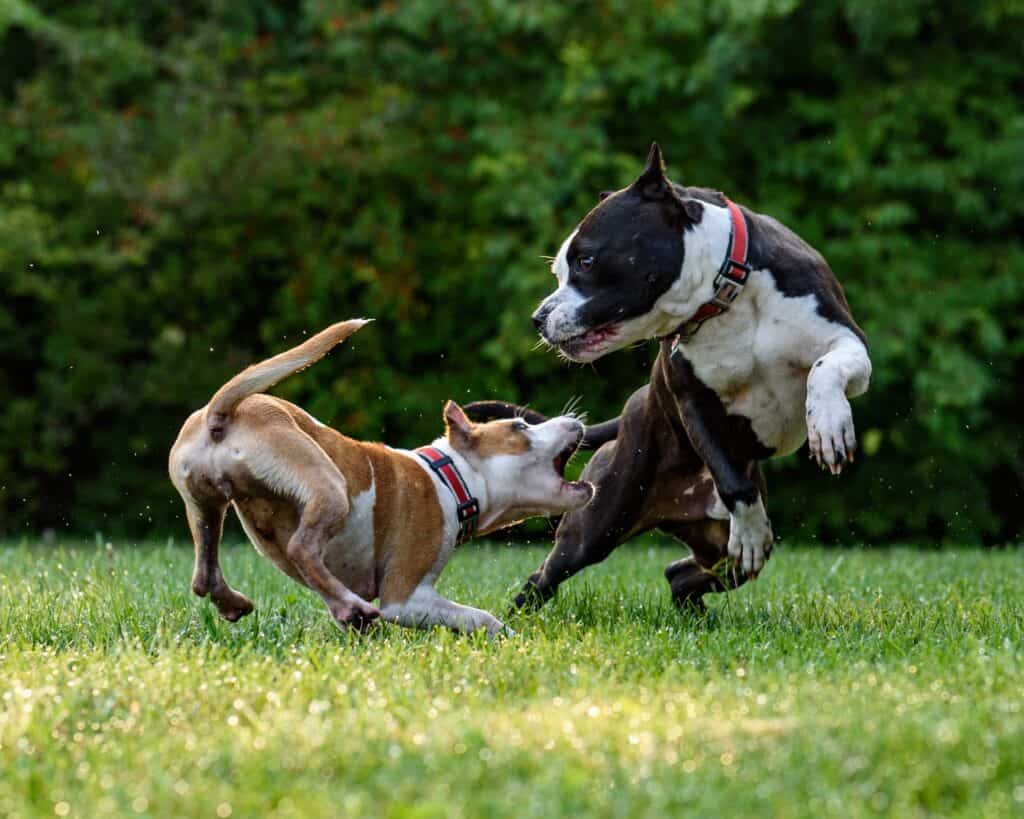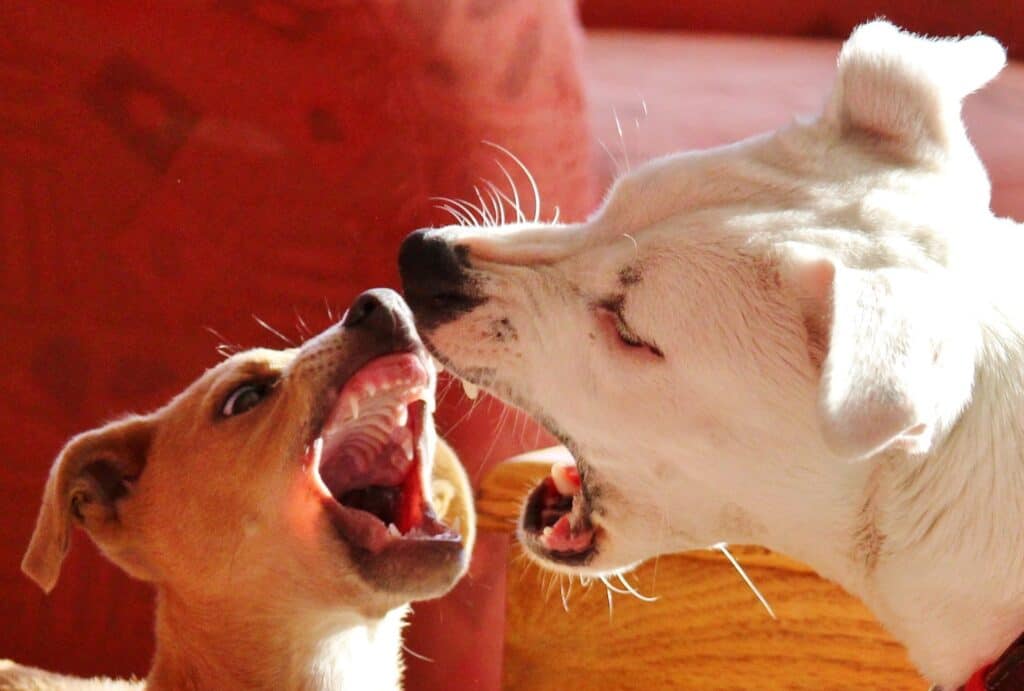how to stop dog aggression towards other dogs
Five helpful tips on How to stop dog aggression towards other dogs, from types of dog aggression to the cause and remedies for aggression towards other dogs. Aggression in dogs is a serious danger to not only other dogs but humans as well follow these tips to help stop dog aggression. If these tips dont work seek professional help Toronto Dog training Facility Royal Companion Kennels Suggests.
Living with a dog that displays aggressive conduct toward other canines can present difficulties. Even a basic walk outdoors can turn into a troublesome and tense experience for the owner. Aggressive behavior is characterized by barking, lunging, and biting other creatures.
Merely because a dog displays aggression towards other dogs, it does not necessarily imply that the dog is inherently aggressive. It indicates that the dog requires training or perhaps is lacking something in its life.
Fortunately, there exist methods to instruct a dog to become more obedient and eliminate its dangerous aggressive tendencies. Owners can typically enhance their dog’s conduct with the assistance of a few tips and techniques unless it is a severe problem.
types of aggression in dogs
Territorial Aggression Certain dogs will attack and bite someone who enters their territory, regardless of whether the person is a friend or an enemy.
Protective Aggression Dogs may exhibit aggressive behavior when they believe that one of their family members or friends is in danger.
Possessive Aggression Many dogs have a tendency to protect their belongings from others, even if it’s not necessary.
Fear Aggression A dog that is afraid may become aggressive if they feel cornered or trapped.
Defensive Aggression Motivated by fear, defensively aggressive dogs believe that a strong offense is the best defense.
Social Aggression A dog that perceives itself as being of higher status may display aggression towards family members.
Frustration-Elicited Aggression When a dog is excited or aroused by something but is prevented from approaching it, it may become aggressive.
Redirected Aggression Redirected aggression occurs when a dog is aroused by or displays aggression towards a person or animal, and someone else interferes.
Pain-Elicited Aggression Even a typically gentle and friendly dog may behave aggressively when they are in pain.
Sex-Related Aggression Intact male dogs will still compete for the attention of females in heat, and females will still compete for access to a male.
Predatory Aggression Some pet dogs exhibit typical predatory behaviors, such as chasing and grabbing fast-moving objects.
Determine what causes a dog’s aggression
Aggression towards other dogs is typically triggered by an underlying cause. The following are the most frequent reasons for this behaviour:
- Fearfulness
- Over-protectiveness
- Dominant dog
- Stress
- Curiosity
- Overexcited states
To address your dog’s aggression problem, it is important to determine its cause. One effective method is to closely observe your dog’s interaction with other dogs. If their tails are wagging, it may indicate over-excitement or hyperactivity, which can be corrected by gently pulling the leash to the side.
To address fear issues, it may be necessary to increase your pet’s exposure to other dogs for socialization purposes. This will aid in fostering trust and facilitating play.
Can you break dog aggression towards other dogs?
Inter-dog aggression cannot be completely cured, but it can be managed effectively through focused treatment. To control the problem, owners must acquire the necessary skills to prevent situations that trigger aggressive behavior in their dogs. Additionally, they should promptly and safely intervene in conflicts between dogs. In circumstances where aggressive behavior is more likely to arise, such as during walks in the park, it is crucial to keep the dog away from potential victims and maintain constant supervision. Furthermore, it may be beneficial for owners to train their dogs to feel at ease wearing a protective head halter and basket muzzle.
Achieve the role of the leader of the pack while walking
Why is my dog aggressive to other dogs on walks ? Mastering the daily walks with your dog is an essential initial task. Often, aggressive behavior in dogs occurs during these walks. As the owner, it is imperative to establish your role as the pack leader. Here are some techniques to become a competent pack leader:
- .To establish yourself as the pack leader, communicate with your animal through body language and energy. Always display confident behaviour during the walk. Keep your shoulders back, your head held high, and maintain a steady pace.
- When a dog detects a human’s weakness or fear, it may exploit it and persist with bad or aggressive conduct. It is essential to never walk next to your dog while feeling afraid or submissive. Avoid nervously looking around and pointing out other dogs or frequently pulling your pet away from other dogs.
- Ensure that the collar is positioned at the highest point of the dog’s neck since it’s a sensitive area. If you tug on the collar, the animal will feel it and come out of its aggressive state.
- When walking a dog, it is important to position them either beside or behind you, never in front. Allowing a dog to pull and lead the way can give the impression that the owner is in need of protection, potentially leading to an aggressive attack. If other dogs approach, the pulling dog may view them as a threat.

Why is my dog only aggressive toward other dogs?
Why is my dog aggressive towards other dogs all of a sudden ? Dogs often display aggression towards other dogs due to dominance. Although dogs are naturally sociable as pack animals, packs establish hierarchies. Typically, an alpha dog asserts dominance within a pack by using threats or physical aggression.
Always discourage negative conduct
Dog aggressive to other dog in house, dogs tend to repeat negative behavior if not provided with clear boundaries and limitations. As the leader of the pack, it is the owner’s responsibility to train the dog and establish acceptable and unacceptable behavior. Although it can be challenging to discipline our beloved pets, it is essential to take on a leadership role in these situations.
- Owners of small dogs often struggle with training due to lack of rule reinforcement. Aggressive behaviour in small dogs commonly presents itself as barking or snapping at other dogs. In response, owners often pick up and hold their dog, which can reinforce the behaviour as a reward for trying to protect or control the owner. Instead, it is recommended to allow the small dog to walk by the other dog and snap out of the barking state on their own.
- When walking with your aggressive dog and another dog is approaching, do not cross the street or pull your dog far away. If you panic, your dog will perceive the other dog as a threat and may lunge, bark, or attack other dogs in an attempt to protect you.
- It is not advisable to yell at a dog as it may increase the dog’s energy level, leading to excitement and aggression. It is recommended to maintain a calm tone while communicating with the dog, even during stressful situations.
- To avoid panicking the animal and causing it to lunge harder, refrain from pulling the leash back during challenging moments. Instead, opt to pull the leash upwards or to the side while simultaneously using the tip of your foot to touch the ribcage area. This action will snap the dog out of its aggressive behaviour.
Instruct the canine on avoidance to stop dog aggression
Practicing avoidance can make walks easier for you and your dog. This involves ignoring other dogs and their owners, even if it may come across as impolite. By doing so, your dog can avoid getting fixated on other animals and prevent obsessing over them. Remember to only introduce your dog to other dogs when necessary.
To walk properly, maintain an upright posture with your head held high and gaze forward. Walk at a comfortable pace and refrain from making eye contact with other dogs or their owners. Avoiding eye contact conveys the message that you wish to avoid conflict and not engage in any confrontations. Dogs are smart and can learn quickly. If you consistently show restraint, your dog will eventually learn to disregard other dogs unless directly interacting with them.
Teaching your dog to avoid other dogs can be done by diverting their attention. Always have some tasty treats on hand, and when you sense danger while out walking, distract your dog with treats. This is an effective method to prevent your dog from fixating or obsessing over other animals since most dogs will gladly accept the treat and stop worrying about nearby animals.
Keep practicing
Consistency and practice are vital to promoting sociability and happiness in dogs. Being a pack leader is a challenging task that requires constant reinforcement of good behaviour rather than bad behaviour. It is crucial to keep in mind that dogs often have a reason for behaving aggressively. As a responsible dog owner, you should consider all options and be prepared to make small corrections whenever necessary to stop dog aggression.
KEY Points on how to stop dog aggression towards other dogs
- Determine what causes a dog’s aggression
- Achieve the role of the leader of the pack while walking
- Correct it through countercondition and decentalization
- Instruct the canine on avoidance
- Always discourage negative conduct

